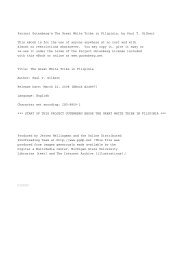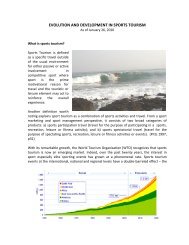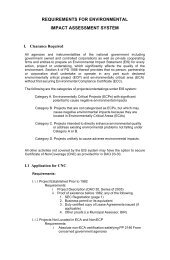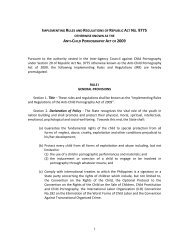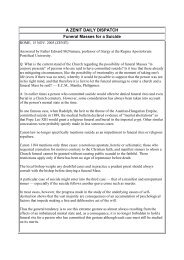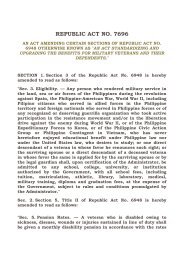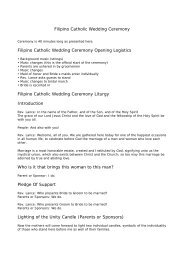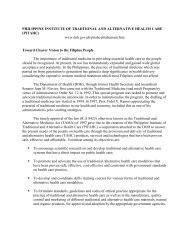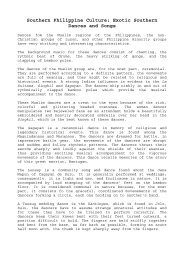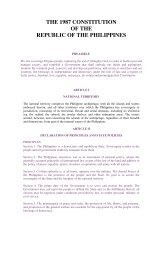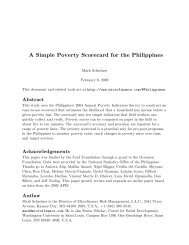Development in the Supply chain of the Philippine Agri-tourism ...
Development in the Supply chain of the Philippine Agri-tourism ...
Development in the Supply chain of the Philippine Agri-tourism ...
Create successful ePaper yourself
Turn your PDF publications into a flip-book with our unique Google optimized e-Paper software.
<strong>Development</strong> <strong>in</strong> <strong>the</strong> <strong>Supply</strong> Cha<strong>in</strong> <strong>of</strong> <strong>the</strong>Philipp<strong>in</strong>e <strong>Agri</strong>-<strong>tourism</strong> Industry:An AssessmentPresented byElmer R. Esplanaelmer.esplana@gmail.comSocio-economist & Interdiscipl<strong>in</strong>ary ResearcherNational Secretariat Coord<strong>in</strong>ator,Price and Volume Watch, Bureau <strong>of</strong> Animal IndustryDepartment <strong>of</strong> <strong>Agri</strong>culturePresented at <strong>the</strong>1st International <strong>Agri</strong>culture and Tourism Expo,World Trade Center, Pasay CityJuly 1, 2011
Objectives <strong>of</strong> <strong>the</strong> Presentation• The ma<strong>in</strong> objective <strong>of</strong> <strong>the</strong> study is to document andassess <strong>the</strong> developments <strong>in</strong> <strong>the</strong> Philipp<strong>in</strong>e agri-<strong>tourism</strong><strong>in</strong>dustry supply cha<strong>in</strong>.• Specifically, <strong>the</strong> study aims to: 1) provide a situation on<strong>the</strong> <strong>tourism</strong> <strong>in</strong>dustry both <strong>in</strong> local and <strong>in</strong>ternationalsituation; 2) provide a basel<strong>in</strong>e <strong>in</strong>formation on <strong>the</strong>developments <strong>in</strong> <strong>the</strong> Philipp<strong>in</strong>e agri-<strong>tourism</strong> <strong>in</strong>dustryfrom <strong>in</strong>put supply, production, process<strong>in</strong>g, market<strong>in</strong>gand demand/consumption; 3) identify <strong>the</strong> best practicesalong <strong>the</strong> supply cha<strong>in</strong> approach; 4) provide <strong>the</strong> basel<strong>in</strong>e<strong>tourism</strong> competitiveness <strong>of</strong> agri-<strong>tourism</strong> with someASEAN countries; 5) suggest solutions for <strong>the</strong> gaps andproblems encountered by <strong>the</strong> <strong>in</strong>dustry along <strong>the</strong> supplycha<strong>in</strong>; and 5) recommend strategic directions for <strong>the</strong>Philipp<strong>in</strong>e agri-<strong>tourism</strong> <strong>in</strong>dustry.
Figure 1. Conceptual Framework for <strong>the</strong> <strong>Agri</strong>-<strong>tourism</strong> Industry<strong>Supply</strong> Cha<strong>in</strong> and <strong>Development</strong> Assessment
Results <strong>of</strong> <strong>the</strong> Study• <strong>Supply</strong> Cha<strong>in</strong> -<strong>the</strong> core bus<strong>in</strong>ess process <strong>in</strong> anyorganization that creates and delivers aproduct or service, from concept throughdevelopment and manufactur<strong>in</strong>g orconversion, and <strong>in</strong>to a market forconsumption. It is called as <strong>the</strong> “seed to shelf”or “breed to plate” or “farm to spoon”approach.
Mission <strong>of</strong> <strong>Supply</strong> Cha<strong>in</strong>• The mission <strong>of</strong> supply cha<strong>in</strong>, as a managementapproach, is <strong>the</strong> ability <strong>of</strong> <strong>in</strong>dividualagribus<strong>in</strong>ess firm/agri-<strong>tourism</strong> establishmentor an <strong>in</strong>dustry “to enhance <strong>the</strong> customer’sexperience through excellence <strong>in</strong> deliver<strong>in</strong>g<strong>the</strong> right products, services, resources and<strong>in</strong>formation seamlessly to <strong>the</strong> right place at<strong>the</strong> right time.”
Industry Focus <strong>of</strong> <strong>Supply</strong> Cha<strong>in</strong> Management• The <strong>in</strong>dustry focus <strong>of</strong> supply cha<strong>in</strong>management <strong>in</strong>cludes activities such as 1)<strong>in</strong>tegrated behavior, 2) mutual shar<strong>in</strong>g <strong>of</strong><strong>in</strong>formation, 3) mutual shar<strong>in</strong>g <strong>of</strong> risk andrewards, 4) cooperation, 5) same goal andsame focus on serv<strong>in</strong>g customers, 6)<strong>in</strong>tegration <strong>of</strong> processes, 7) partnership <strong>in</strong>build<strong>in</strong>g and ma<strong>in</strong>ta<strong>in</strong><strong>in</strong>g long-termrelationships among each <strong>in</strong>dustrystakeholder.
Figure 2. <strong>Agri</strong>-<strong>tourism</strong> Industry <strong>Supply</strong>Cha<strong>in</strong> FrameworkInput <strong>Supply</strong> Production Process<strong>in</strong>g Market<strong>in</strong>gConsumptionSource: Esplana, Abao, Vasquez, 2007
World Tourism Situation• In 2010, <strong>in</strong>ternational <strong>tourism</strong> receiptsare estimated at $919 billion worldwidehigher than <strong>the</strong> $851 billion <strong>in</strong> 2009(UNWTO, May 2011) .• No. <strong>of</strong> tourist worldwide was recorded at880 million <strong>in</strong> 2009.• Top three <strong>in</strong>ternational touristdest<strong>in</strong>ations <strong>in</strong> 2010 are France (79 M),Ch<strong>in</strong>a (56 M) and United States (61 M).
No. <strong>of</strong> Arrivals and Receipts <strong>of</strong> <strong>the</strong> Tourism Industry and itscontribution to GDPNo. <strong>of</strong> Arrivals and Receipts fromTourism Industry2006 2007 2008 2009 2010GR(2006-2010)PercentChange2010/2009Total Arrivals 2,843,345 6,080,591 3,139,422 3,017,099 3,520,471 (2.70) 16.68Total Receipts (In $ Million) 3,465 4,622 2,429 2,236 2,490 (12.95) 11.36Converted to PhP (In PhP Million) 177,803.01 213,275.75 108,029.78 106,516.33 112,323.90 (14.90) 5.45GDP 6,031,164 6,648,619 7,409,371 7,678,917 8,513,037 8.69 10.86% Share to GDP 2.95 3.21 1.46 1.39 1.32 (21.70) (4.88)In general, dur<strong>in</strong>g <strong>the</strong> last five years for <strong>the</strong> no. <strong>of</strong> arrivals and totalreceipts <strong>of</strong> tourist <strong>in</strong>dustry <strong>in</strong> <strong>the</strong> Philipp<strong>in</strong>es, it has been <strong>in</strong> decreas<strong>in</strong>gtrends.The average contribution <strong>of</strong> <strong>the</strong> <strong>tourism</strong> <strong>in</strong>dustry <strong>in</strong> <strong>the</strong> last five yearswas posted at two percent <strong>of</strong> <strong>the</strong> gross domestic product.
No. <strong>of</strong> Foreign Tourists Arrivals <strong>in</strong> 2010 from country <strong>of</strong> residences (subcont<strong>in</strong>ent)7,411, 0%21,821, 1%32,388, 1%3,584,0%203,211, 6%52,066, 2%ASEAN298,176, 9%East AsiaSouth Asia150,178,5%3,650, 0% 149,193, 5%Middle EastNorth AmericaCentral AmericaSouth AmericaWestern Europe707,705, 21%Nor<strong>the</strong>rn Europe1,563,013, 47%Sou<strong>the</strong>rn EuropeEastern EuropeEastern Mediterranean Europe*48,716, 1%50,914, 2%OceaniaAfricaO<strong>the</strong>rs and Unspecified ResidencesThe biggest arrivals came from East Asia, North America and ASEAN
Source: DOTSouth Korea is <strong>the</strong> country with <strong>the</strong> highest no. <strong>of</strong> tourist arrivals(740,622 or 21%) or source <strong>of</strong> market, followed by United States600,165 or 17%, Japan (12%), Ch<strong>in</strong>a (7%) and Australia (3%).
Comparative Foreign and Domestic Tourists from 2009 to 20102010 2009 Growth RateDest<strong>in</strong>ations Foreign Domestic Total Foreign Domestic Total Foreign Domestic TotalCamar<strong>in</strong>es Sur 310,063 1,569,109 1,879,172 206,937 1,022,092 1,229,029 49.83% 53.52% 52.90%Metro Manila 1,111,152 576,680 1,687,832 879,577 516,168 1,395,745 26.33% 11.72% 20.93%Cebu 528,145 784,790 1,312,935 484,341 749,361 1,233,702 9.04% 4.73% 6.42%Boracay Island 230,459 377,078 607,537 163,820 343,076 506,896 40.68% 9.91% 19.85%Davao City 46,084 462,668 508,752 55,090 614,774 669,864 -16.35% -24.74% -24.05%Baguio City* 22,672 412,527 435,199 30,194 501,229 531,423 -24.91% -17.70% -18.11%Bohol 79,584 170,561 250,145 73,660 167,010 240,670 8.04% 2.13% 3.94%Zambales** 49,781 197,794 247,575 57,146 189,283 246,429 -12.89% 4.50% 0.47%Cagayan Valley 10,793 218,968 229,761 10,709 214,904 225,613 0.78% 1.89% 1.84%Puerto Pr<strong>in</strong>cesa City** 24,440 189,378 213,818 18,328 178,418 196,746 33.35% 6.14% 8.68%Camigu<strong>in</strong> Island 5,650 172,178 177,828 5,792 152,087 157,879 -2.45% 13.21% 12.64%Negros Oriental 36,088 139,310 175,398 34,838 143,727 178,565 3.59% -3.07% -1.77%Ilocos Norte 13,067 126,918 139,985 10,279 128,844 139,123 27.12% -1.49% 0.62%TOTAL 2,467,978 5,397,959 7,865,937 2,030,711 4,920,973 6,951,684 21.53% 9.69% 13.15%*January-August only**partial report as <strong>of</strong> September 2010Sources <strong>of</strong> Data: DOT Regional Offices/ Local Tourism Offices/ Accommodation EstablishmentsThe top five tourists dest<strong>in</strong>ations <strong>in</strong> 2010 are: MetroManila with 21-percent growth, Camar<strong>in</strong>es Sur, 53%;Cebu, 6.42%; Boracay Island, 19.85%; and Davao City(-24%).
Occupancy Rates and Length <strong>of</strong> Stay <strong>of</strong> Guests (<strong>in</strong>nights) for <strong>the</strong> different type <strong>of</strong> accommodations <strong>in</strong>Metro Manila by classified hotelsType <strong>of</strong> Accomodations Occupancy Rates (%) Length <strong>of</strong> Stay <strong>of</strong> Guests (<strong>in</strong> nights)De Luxe 64.58 2.63First Class 60.34 2.47Standard 67.35 2.39Economy 64.63 1.98Source : DOTThe Standard Room (67.35%) accommodations had <strong>the</strong>highest occupancy rate while <strong>the</strong> De Luxe Room (2.63) hadhighest length <strong>of</strong> stay for guests.
What is <strong>Agri</strong>-<strong>tourism</strong>?• <strong>Agri</strong>-<strong>tourism</strong> is a form <strong>of</strong> niche <strong>tourism</strong> that isconsidered a growth <strong>in</strong>dustry <strong>in</strong> many parts <strong>of</strong> <strong>the</strong>world, <strong>in</strong>clud<strong>in</strong>g Australia, Canada, US, and <strong>the</strong>Philipp<strong>in</strong>es (Wikipedia).• It is sometimes called as “farm or rural <strong>tourism</strong>”which is a fast expand<strong>in</strong>g <strong>tourism</strong> product thatacts as a supplemental activity to <strong>the</strong> ma<strong>in</strong> activity<strong>of</strong> farm<strong>in</strong>g. This is characterized by a l<strong>in</strong>k betweentravel and products, services and experiences <strong>of</strong><strong>the</strong> agriculture and food systems.(http://www.gov.nf.ca).
<strong>Agri</strong>-<strong>tourism</strong> Industry <strong>in</strong> <strong>the</strong> Philipp<strong>in</strong>es• <strong>Agri</strong>-<strong>tourism</strong> concept <strong>in</strong> <strong>the</strong> Philipp<strong>in</strong>es <strong>in</strong>volve activitieswhich maximizes <strong>the</strong> potential <strong>of</strong> <strong>in</strong>come generation <strong>of</strong>exist<strong>in</strong>g farms <strong>in</strong> <strong>the</strong> country through <strong>tourism</strong> relatedactivities.• This on-farm diversification scheme aims to openopportunities for livelihood, bus<strong>in</strong>ess and employmentgeneration, and education <strong>of</strong> non-farm<strong>in</strong>g public about farmand farm products and <strong>the</strong> preservation <strong>of</strong> rural landscape.• It is a <strong>tourism</strong> where <strong>the</strong> work<strong>in</strong>g environment forms part <strong>of</strong><strong>the</strong> tourist product.• It likewise covers attractions, activities, services, andamenities as well as cultural resources <strong>of</strong> <strong>the</strong> area. It is<strong>in</strong>tended to promote an appreciation <strong>of</strong> local culture,heritage and traditions through personal contact with localpeople (DOT, Philipp<strong>in</strong>e <strong>Agri</strong>-<strong>tourism</strong> Concept Paper, 1999)
<strong>Agri</strong>-<strong>tourism</strong> Industry <strong>in</strong> <strong>the</strong> Philipp<strong>in</strong>es• It is considered as an emerg<strong>in</strong>g <strong>in</strong>dustry developedas a niche market both <strong>of</strong> <strong>the</strong> agriculture and<strong>tourism</strong> sectors.• There are some agribus<strong>in</strong>ess establishments that<strong>of</strong>fer agri-<strong>tourism</strong> products and services, as avalued-added from <strong>the</strong>ir core bus<strong>in</strong>ess <strong>in</strong> <strong>the</strong> farmsto <strong>in</strong>crease <strong>the</strong>ir pr<strong>of</strong>itability or competitiveness, asa bus<strong>in</strong>ess entity.• While some agri-<strong>tourism</strong> sites had <strong>in</strong>tentionallydeveloped bus<strong>in</strong>ess models which basically made<strong>tourism</strong> as <strong>the</strong>ir core bus<strong>in</strong>ess, but only few aredo<strong>in</strong>g this at <strong>the</strong> moment, among <strong>the</strong> new entrant to<strong>the</strong> <strong>in</strong>dustry, due to availability <strong>of</strong> enough capital<strong>in</strong>vestment.
Input <strong>Supply</strong>• Suppliers <strong>of</strong> bus<strong>in</strong>ess ideas, concept/bus<strong>in</strong>ess model.• Suppliers <strong>of</strong> raw materials used as <strong>in</strong>put to production<strong>of</strong> agricultural products and <strong>the</strong> operation <strong>of</strong> <strong>the</strong> agri<strong>tourism</strong>establishment.• Suppliers <strong>of</strong> kitchen equipments & technology.• Providers <strong>of</strong> technical assistance (skills, knowledge,desirable values) such as academicians, pr<strong>of</strong>essionals,consultants & experts <strong>in</strong> <strong>the</strong> different segments <strong>of</strong> <strong>the</strong>agri-<strong>tourism</strong> bus<strong>in</strong>ess.• The complexity <strong>of</strong> <strong>in</strong>put supply <strong>in</strong> an agri-<strong>tourism</strong>establishment is dependent on <strong>the</strong> bus<strong>in</strong>ess modelthat a farmer-entrepreneur decided to develop.• There are some <strong>in</strong>dustry players that are highly<strong>in</strong>tegrated <strong>in</strong> operation from <strong>in</strong>put supply to market<strong>in</strong>g,e.g. Bohol Bee Farm and Ilog Maria Honeybee Farm.
Sourc<strong>in</strong>g raw materials ei<strong>the</strong>r <strong>in</strong><strong>in</strong>ternal or external suppliers• In <strong>the</strong> <strong>in</strong>put supply subsystem, it is observed thatamong <strong>the</strong> agri-<strong>tourism</strong> sites, <strong>the</strong> purchas<strong>in</strong>g <strong>of</strong> rawmaterials requirement for <strong>the</strong>ir operations areei<strong>the</strong>r supplied through <strong>the</strong>ir exist<strong>in</strong>g farm <strong>in</strong>putoperation while some have been purchas<strong>in</strong>g itthrough <strong>the</strong>ir regular suppliers.• Some <strong>of</strong> <strong>the</strong> players <strong>in</strong> <strong>the</strong> <strong>in</strong>put supply subsystem<strong>in</strong>clude: breeders and feeds supplier for livestock,seeds and seedl<strong>in</strong>gs supplier, fertilizer and pesticidesupplier for crops, agricultural/process<strong>in</strong>gmach<strong>in</strong>ery suppliers, food and beverages suppliersand o<strong>the</strong>r agricultural <strong>in</strong>puts. Most <strong>of</strong> <strong>the</strong> labor aresourced from with<strong>in</strong> <strong>the</strong> area where <strong>the</strong> farm islocated.
Production-Process<strong>in</strong>g• Creation <strong>of</strong> goods and services• In agri-<strong>tourism</strong> bus<strong>in</strong>ess, <strong>the</strong> distribution <strong>of</strong>production load <strong>in</strong> <strong>the</strong> operations <strong>of</strong> agri-<strong>tourism</strong>sites <strong>in</strong>clude: 70% <strong>of</strong> production is goods while30 % <strong>of</strong> production is services or vice versadepend<strong>in</strong>g on <strong>the</strong> bus<strong>in</strong>ess model.
Production Activities <strong>of</strong> <strong>Agri</strong>-<strong>tourism</strong> Sites• The production subsystem activities <strong>in</strong> agri<strong>tourism</strong><strong>in</strong>dustry <strong>in</strong>clude: production <strong>of</strong> farm andprocessed products, conduct or participate <strong>in</strong>trade fairs, exhibit, farm direct market<strong>in</strong>g,acceptance <strong>of</strong> farm tours and conduct <strong>of</strong> tra<strong>in</strong><strong>in</strong>g.Only few have farm stay or overnightaccommodation capability.• Some have a regular farm tours organized by<strong>the</strong>m or by ei<strong>the</strong>r <strong>the</strong>ir network tour guideoperators, travel agencies or travel association.O<strong>the</strong>rs have o<strong>the</strong>r value-added products such asconsultancy services for <strong>the</strong>ir farm commodityexpertise.
Selected <strong>Agri</strong>-<strong>tourism</strong> Sites <strong>in</strong> <strong>the</strong> Philipp<strong>in</strong>esName <strong>of</strong> EstablishmentsSource: Farm Visits, Interviews/WebsitesLocationDay TourFarm CategoryFarm Stay (withovernight facility)Gourmet Farm Silang, Cavite XSonya's Garden Alfonso, Cavite X XM<strong>in</strong>danao Baptist Rural Life Center Bansalan, Davao del Sur X XTrappist Monastery Jordan, Guimaras XIlog Maria Honeybee Farm Silang, Cavite XBohol Bee Farm, Resort and Restaurant Panglao Island, Bohol X XDel Monte Philipp<strong>in</strong>es Inc. Camp Philips Bukidnon XMenzi <strong>Agri</strong>cultural <strong>Development</strong> Camilag, Manolo Fortich, Bukidnon XTomato Farms NFC, Sarrat, Piddig, Ilocos Norte XNational Apiculture Research Tra<strong>in</strong><strong>in</strong>g, Devt. Inst. DMMMSU-NARTDI, Bacnotan, La Union X XCentral Luzon State University Munoz Science City, Nueva Ecija X XUniversity <strong>of</strong> <strong>the</strong> Philipp<strong>in</strong>es Los Banos College, Laguna X XLos Banos Horticulture Society RGC, Calamba City, Laguna XHacienda Macalauan Inc. Calauan, Laguna XPamora Farm Pidigan, Abra XCostales Nature Farms Majayjay, Laguna XPalawan Butterfly Garden Puerto Pr<strong>in</strong>cesa, Palawan XJuboken Farm and Enterprise Camalig, Albay X
Selected <strong>Agri</strong>-<strong>tourism</strong> Sites <strong>in</strong> <strong>the</strong> Philipp<strong>in</strong>esand Mode <strong>of</strong> Reservation for Farm/Plant TourName <strong>of</strong> EstablishmentsWebsite/BlogsAvailability<strong>of</strong> WebsiteAvailability <strong>of</strong>onl<strong>in</strong>eMode <strong>of</strong>Reservation/Accessibilityreservation <strong>of</strong> Farm/Plant TourGourmet Farm www.gourmet.com.ph Yes None call/telephone, emailSonya's Garden www.sonyasgarden.com Yes None call/telephone, emailM<strong>in</strong>danao Baptist Rural Life Center http://mozcom.com/~mbrlc/<strong>in</strong>dex.htm Yes None call/telephone, emailTrappist Monastery through blogs and pr<strong>of</strong>ile account onl<strong>in</strong>e No None call/telephone, emailBohol Bee Farm, Resort and Restaurant www.boholbeefarm.com/www.boholbeefarm-panglao.com Yes Yes onl<strong>in</strong>e reservationDel Monte Philipp<strong>in</strong>es Inc. http://www.delmontepacific.com Yes None call/telephone, emailMenzi <strong>Agri</strong>cultural <strong>Development</strong> through blogs and pr<strong>of</strong>ile account onl<strong>in</strong>e No none call/telephone, emailTomato Farms www.nfc.gov.ph Yes None call/telephone, emailNational Apiculture Research Tra<strong>in</strong><strong>in</strong>g, Devt. Inst. http://nartdidmmmsu.multiply.com/ Yes None call/telephone, emailCentral Luzon State University www.clsu.edu.ph Yes None call/telephone, emailUniversity <strong>of</strong> <strong>the</strong> Philipp<strong>in</strong>es Los Banos www.uplb.edu.ph Yes None call/telephone, emailLos Banos Horticulture Society www.lbhs-ph.org Yes None call/telephone, emailHacienda Macalauan Inc. www.hmi.net.ph Yes None call/telephone, emailPamora Farm www.pamorafarm.com Yes None call/telephone, emailCostales Nature Farms www.costalesnaturefarms.com Yes None call/telephone, emailPalawan Butterfly Garden through blogs and pr<strong>of</strong>ile account onl<strong>in</strong>e none None call/telephone, emailJuboken Farm and Enterprise through blogs and pr<strong>of</strong>ile account onl<strong>in</strong>e none None call/telephone, emailSource: Websites/Internet
<strong>Agri</strong>-<strong>tourism</strong> Mode <strong>of</strong> Reservation• When it comes to mode <strong>of</strong> reservation for farmtour, phone calls (landl<strong>in</strong>e/mobile) and emailcommunications are <strong>the</strong> most widely usedmeans <strong>of</strong> communication tools.• Among <strong>the</strong> identified 17 selected agri-<strong>tourism</strong>sites, only Bohol Bee Farm and Ilog MariaHoneybee Farm had <strong>the</strong> onl<strong>in</strong>e reservationfacility/could purchase <strong>the</strong>ir product for salethrough an e-commerce facility.
Selected <strong>Agri</strong>-<strong>tourism</strong>Establishments/Players with BestPractices
Bohol Bee Farm• Bohol Bee Farm which is an organic bee farm withhotel resort and restaurant. They have 17 productsfrom honey and honeybee by-products that arecurrently <strong>of</strong>fer<strong>in</strong>g to <strong>the</strong>ir clients. Some <strong>of</strong> <strong>the</strong>seproducts <strong>in</strong>clude: pure honey, honey spread, beepollen, honeyed salabat, bee propolis, honeyedmuff<strong>in</strong>s. Bohol Bee Farm is promot<strong>in</strong>g organicfarm<strong>in</strong>g.
Ilog Maria Honeybee Farm• Ilog Maria Honeybee Farm is an <strong>in</strong>tegrated bee farm operator with awebsite shopp<strong>in</strong>g cart as <strong>the</strong>ir ma<strong>in</strong> mode <strong>of</strong> purchas<strong>in</strong>g <strong>the</strong>irproduct. Be<strong>in</strong>g an <strong>in</strong>tegrated operator <strong>in</strong> <strong>the</strong> honeybee <strong>in</strong>dustry, <strong>the</strong>yare <strong>the</strong> most number <strong>of</strong> processed products and by-productproduced from honey and bee products. Some <strong>of</strong> <strong>the</strong>ir products<strong>in</strong>clude: honey, natural bee pollen pellets, raw propolis, fresh RoyalJelly, scented beewax candles, beewax, propolis soap and shampoos,honey cedar v<strong>in</strong>egar, bee venom, to name a few. Based on <strong>the</strong>irwebsite <strong>the</strong>re are two means <strong>of</strong> payment for Ilog Maria productssuch as: 1) <strong>the</strong> usual way, by mak<strong>in</strong>g a deposit to <strong>the</strong>ir account andfax<strong>in</strong>g <strong>the</strong> deposit slip to <strong>the</strong>m; and 2) a newer way by GCash andSmart money. As part <strong>of</strong> <strong>the</strong>ir value-added services, <strong>the</strong>y host fieldtrips or conduct tours with<strong>in</strong> <strong>the</strong> bee farm for a m<strong>in</strong>imum <strong>of</strong> 50people. Tour <strong>in</strong> Ilog Maria is designed for walk<strong>in</strong>g through along <strong>the</strong>fresh cool air and walk around <strong>the</strong>ir garden. They have established<strong>the</strong>ir own museum which <strong>the</strong>y call “Museo sa Ilog Maria.” There areo<strong>the</strong>r value-added services that <strong>the</strong>y are do<strong>in</strong>g that <strong>in</strong>clude beesem<strong>in</strong>ar, contract poll<strong>in</strong>ation services and bee project consultancy.
M<strong>in</strong>danao Baptist Rural Life Center• MBRLC is a private volunteer organization whose ma<strong>in</strong> objective is to helpall people, especially upland farmers. MBRLC has developed <strong>in</strong>to a 19-hademonstration farm with seven satellite projects throughoutM<strong>in</strong>danao. They are <strong>in</strong>volved <strong>in</strong> local village development programs. Over20,000 visitors come to <strong>the</strong> Center per year with about 2,000 <strong>of</strong> those be<strong>in</strong>gone-week tra<strong>in</strong>ees per year. They are primarily promot<strong>in</strong>g susta<strong>in</strong>abledevelopment for <strong>the</strong> uplands utiliz<strong>in</strong>g agriculture, health care, literacy, andcommunity organiz<strong>in</strong>g, among o<strong>the</strong>rs with tie-ups <strong>in</strong> over 12 Asiancountries. "People who come to <strong>the</strong> farm don't only see what we do butalso learn someth<strong>in</strong>g.“ – Roy Alimoane, MBRLC, Director• As to <strong>the</strong> commodities, <strong>the</strong>y are <strong>in</strong>to livestock and aquaculture production,organic fertilizer, seed production, tra<strong>in</strong><strong>in</strong>g and agricultural andagr<strong>of</strong>orestry technology promotion.• Almost daily, group tour arrive to see <strong>the</strong>ir “Disneyland <strong>of</strong> susta<strong>in</strong>ablefarm<strong>in</strong>g systems” which accord<strong>in</strong>g to <strong>the</strong>m, <strong>the</strong>y have developed through<strong>the</strong> years <strong>of</strong> experimentations and consultations.• Most <strong>of</strong> <strong>the</strong>ir visitors, came from Asia such as Afghanistan, Bangladesh,Bhutan, Brunei, Burma (Myanmar), Cambodia, Ch<strong>in</strong>a, East Timor, India,Indonesia, Japan, Laos, Malaysia, Mongolia, Nepal, Pakistan, Papua NewGu<strong>in</strong>ea, S<strong>in</strong>gapore, South Korea, Sri Lanka, Taiwan, Thailand, and Vietnam.There are also some who came from Australia and Zimbabwe.
Lao Integrated Farm, Inc.• Lao Integrated Farm, Inc., located <strong>in</strong> Brgy.Eman, Bansalan, Davao del Sur has an<strong>in</strong>tegrated multi-commodities goat farm undercoconut trees, pig production, organicfertilizer, fruits, vegetables and value-addedproducts. Around 700 people visit <strong>the</strong> farmper month.
Best Practices among EducationalInstitutions• Some <strong>of</strong> <strong>the</strong> most popular agri-<strong>tourism</strong> sites <strong>in</strong><strong>the</strong> country <strong>in</strong>clude <strong>the</strong> Central Luzon StateUniversity for <strong>in</strong>tegrated farm<strong>in</strong>g, University<strong>of</strong> <strong>the</strong> Philipp<strong>in</strong>es Los Banos for <strong>the</strong>irexcellence as an agricultural –educational<strong>in</strong>stitution, nature and agr<strong>of</strong>orestry farm<strong>in</strong>gconcept that <strong>the</strong>y are promot<strong>in</strong>g <strong>in</strong> <strong>the</strong>ir area,and Don Mariano Marcos Memorial StateUniversity for <strong>the</strong>ir apiculture and sericulture
Learn<strong>in</strong>gs from <strong>the</strong> best practices <strong>of</strong>some agri-<strong>tourism</strong> players• There should be a bus<strong>in</strong>ess model• There should be an advocacy e.g. natural or organicfarm<strong>in</strong>g, nature/environment-friendly, wellness andclient-friendly.• The importance <strong>of</strong> value-added products and services• Integrated operation and diversification from <strong>the</strong> corebus<strong>in</strong>ess• Effective supply cha<strong>in</strong> management• Application <strong>of</strong> agribus<strong>in</strong>ess management approach <strong>in</strong>operation.
Tourism Competitivenessamong ASEAN countries
Rank <strong>in</strong> terms <strong>of</strong> Measures <strong>of</strong> Tourism Competitiveness forSelected ASEAN Countries, 2007Indices Philipp<strong>in</strong>es S<strong>in</strong>gapore Malaysia Thailand Indonesia VietnamPolicy rules & regulation 61 1 26 55 43 104Environmental Regulation 83 6 20 39 81 84Air Transporation Infrastructure 72 10 31 25 64 90Ground transport <strong>in</strong>frastructure 91 3 15 28 89 85Tourism Infrastructure 93 44 60 53 87 121ICT Infrastructure 83 18 37 58 80 88Price Competitiveness 7 26 2 4 1 10Human Resources 93 2 34 75 62 81National Tourism perception 83 47 26 35 57 51National & cultural resources 95 79 101 77 58 84Overall Index 86 8 31 43 60 87Source: Travel and Tourism Competitiveness Report 2007, World Economic Forum,as lifted from <strong>the</strong> Policy Advisory, Congressional Plann<strong>in</strong>g and Budget Department, HOR, 2008-03Compared to o<strong>the</strong>r five ASEAN member countries, <strong>the</strong> Philipp<strong>in</strong>escompetitiveness is second to <strong>the</strong> last <strong>in</strong> terms <strong>of</strong> overall <strong>tourism</strong>competitiveness <strong>in</strong>dex.
MARKETINGMarket<strong>in</strong>g <strong>Agri</strong>-<strong>tourism</strong> Products• In <strong>the</strong> Philipp<strong>in</strong>es, market<strong>in</strong>g <strong>of</strong> agri-<strong>tourism</strong> products islower than compared with ASEAN countries. Tourismproduct <strong>in</strong> agricultural operation serves as a value-addedservice.• Among <strong>the</strong> five ASEAN countries, identified above, <strong>the</strong>Philipp<strong>in</strong>es has a price competitiveness <strong>of</strong> 7, lower thanS<strong>in</strong>gapore (26) and Vietnam (10) but higher than Malaysia(2) , Indonesia (1) and Thailand (4).• There are 17.18 million regional travellers recorded <strong>in</strong> 2009.Of this total, 13.84 million or 81% are domestic travellers;3.14 million (18%) are foreign travellers and only onepercent (202,940) are Overseas Filip<strong>in</strong>o travellers.
Payment Terms• Most <strong>of</strong> <strong>the</strong> payment <strong>of</strong> products/services <strong>in</strong><strong>the</strong> agri-<strong>tourism</strong> bus<strong>in</strong>ess are be<strong>in</strong>g paid on acash basis while those who have <strong>the</strong> creditcard facility accepts credit card payment.
Demand/Consumption <strong>of</strong> <strong>Agri</strong>-<strong>tourism</strong>Products or Services• The demand <strong>of</strong> agri-<strong>tourism</strong> products has a quality if it hasbeen repeatedly order by <strong>the</strong>ir customers who are satisfiedwith <strong>the</strong>ir products/services.• Consum<strong>in</strong>g or patroniz<strong>in</strong>g agri-<strong>tourism</strong> product is <strong>the</strong>process <strong>of</strong> us<strong>in</strong>g <strong>the</strong>m <strong>in</strong> order to satisfy desires and real orimag<strong>in</strong>ed needs which had to be ei<strong>the</strong>r used up,transformed, or deteriorated/consumed, <strong>in</strong> such a manneras not to be ei<strong>the</strong>r reusable or recognizable <strong>in</strong> <strong>the</strong>ir orig<strong>in</strong>alform.• When it comes to <strong>the</strong> volume <strong>of</strong> tourists who visited <strong>the</strong>country <strong>in</strong> 2010, <strong>the</strong> volume <strong>of</strong> Koreans who travelled <strong>in</strong><strong>the</strong> Philipp<strong>in</strong>es was recorded at 435,701. They are <strong>the</strong>biggest foreign travellers <strong>in</strong> <strong>the</strong> country.
Demand/Consumption <strong>of</strong> <strong>Agri</strong>-<strong>tourism</strong>Products or Services• The second highest volume <strong>of</strong> tourists wereAmericans at 309,493; Japanese ranked no. 3 at291,385; Ch<strong>in</strong>ese ranked no. 4 at 164,728 and <strong>the</strong>top 5 are Australians at 79,552.• In terms <strong>of</strong> <strong>the</strong> type <strong>of</strong> occupation <strong>of</strong> people whoare visit<strong>in</strong>g <strong>the</strong> Philipp<strong>in</strong>es, as <strong>of</strong> 2008 with atotal <strong>of</strong> 3.084 million, pr<strong>of</strong>essional had <strong>the</strong>highest volume which contributed 29% (903,880),followed by students at 11 percent (348,697);and those <strong>in</strong> <strong>the</strong> clerical/sales jobs ranked no. 3 at162,617 tourists.
Support subsystem• Accord<strong>in</strong>g to DOT, currently <strong>the</strong>y are wait<strong>in</strong>g for <strong>the</strong> release<strong>of</strong> <strong>the</strong> new masterplan for <strong>the</strong> <strong>tourism</strong> <strong>in</strong>dustry which <strong>the</strong>yare prepar<strong>in</strong>g dur<strong>in</strong>g this time.• It is assumed that agri-<strong>tourism</strong> should also be given <strong>the</strong>higher priority <strong>in</strong> terms <strong>of</strong> program implementation <strong>in</strong> <strong>the</strong>next five or more years, particularly that <strong>the</strong> strengths <strong>of</strong><strong>the</strong> Philipp<strong>in</strong>es is basically both agriculture and <strong>tourism</strong>.• It is also important to get <strong>the</strong> complementary support <strong>of</strong><strong>the</strong> Department <strong>of</strong> <strong>Agri</strong>culture by provid<strong>in</strong>g an agri<strong>tourism</strong>-relatedprogram <strong>in</strong> collaboration with <strong>the</strong>DOT and o<strong>the</strong>r agencies support<strong>in</strong>g <strong>the</strong> <strong>tourism</strong>development <strong>in</strong> <strong>the</strong> country which will help <strong>in</strong> improv<strong>in</strong>g<strong>the</strong> <strong>in</strong>dustry’s performance <strong>in</strong> <strong>the</strong> succeed<strong>in</strong>g 5 to 20 years.It will also help to improve <strong>the</strong> <strong>tourism</strong> competitiveness <strong>of</strong><strong>the</strong> country, <strong>in</strong> general and <strong>the</strong> agri-<strong>tourism</strong>, <strong>in</strong> particular.• It is observed that except <strong>in</strong> 2010, <strong>the</strong> volume <strong>of</strong> touristarrivals had been <strong>in</strong> <strong>the</strong> decreas<strong>in</strong>g trends at an average <strong>of</strong>three percent per year.
Projected Impact to <strong>Agri</strong>-<strong>tourism</strong> Industry with this 1 stIATE organized by Al<strong>in</strong>ks Events International, Inc.• Provide local employment .• Support local and national development.• Support <strong>the</strong> growth <strong>of</strong> both agriculture and <strong>tourism</strong>sector.• Create awareness and advocacy campaigns, learn<strong>in</strong>gsem<strong>in</strong>ars, product exhibits and cultural performances• Promote agri-<strong>tourism</strong> sites.• Support <strong>the</strong> development and establishment <strong>of</strong> moreagri-<strong>tourism</strong> sites <strong>in</strong> <strong>the</strong> country and o<strong>the</strong>r Asiancountries, as well.• Develop more economic activities among <strong>the</strong>participat<strong>in</strong>g LGUs <strong>in</strong> different parts <strong>of</strong> <strong>the</strong> country,particularly, <strong>the</strong> potential new local and foreign<strong>in</strong>vestments.
Organization <strong>of</strong> an <strong>Agri</strong>-<strong>tourism</strong>Association• When it come to self-organization, <strong>the</strong>re is aneed to organize an agri-<strong>tourism</strong> associationamong our key stakeholders to unify <strong>the</strong>support and advocacy <strong>of</strong> <strong>the</strong> <strong>in</strong>dustry for <strong>the</strong>fur<strong>the</strong>r improvement <strong>of</strong> <strong>the</strong> sector.• The organization <strong>of</strong> <strong>the</strong> group will be important<strong>in</strong> <strong>the</strong>ir participation to policy and programmonitor<strong>in</strong>g <strong>of</strong> <strong>the</strong> different governmentagencies, <strong>in</strong>volved <strong>in</strong> <strong>the</strong> agri-<strong>tourism</strong>development <strong>in</strong> <strong>the</strong> Philipp<strong>in</strong>es.
Conclusion• There are some developments <strong>in</strong> <strong>the</strong> supplycha<strong>in</strong> <strong>of</strong> agri-<strong>tourism</strong> <strong>in</strong>dustry from <strong>in</strong>putsupply, to production-process<strong>in</strong>g, to market<strong>in</strong>gand demand/consumption.• The gaps <strong>in</strong> <strong>the</strong> each segment <strong>of</strong> <strong>the</strong> supplycha<strong>in</strong> could be improved by streng<strong>the</strong>n<strong>in</strong>g <strong>the</strong>supply cha<strong>in</strong> management <strong>of</strong> <strong>the</strong> agri-<strong>tourism</strong><strong>in</strong>dustry stakeholders.
Conclusion• In terms <strong>of</strong> production <strong>of</strong> agri-<strong>tourism</strong>products/services, <strong>the</strong> convergence effort <strong>of</strong>DA and DOT through <strong>the</strong>ir program supportand improvement <strong>in</strong> <strong>the</strong> regulatory andstandards <strong>in</strong> <strong>the</strong> agri-<strong>tourism</strong> <strong>in</strong>dustry is amust. Based on my <strong>in</strong>terview with an DOT<strong>in</strong>sider,<strong>the</strong>re is no current clear registrationmechanism <strong>in</strong> accredit<strong>in</strong>g/polic<strong>in</strong>g <strong>the</strong> agri<strong>tourism</strong>establishments.
Conclusion• The best practices are demonstrated by selected successfulplayers such as M<strong>in</strong>danao Baptist and Rural Life Center,Bohol Bee Farm, Ilog Maria Honey Bee Farm, and LaoIntegrated Farm, Inc and <strong>the</strong> <strong>in</strong>itially developed bestpractices among some state colleges and universities <strong>in</strong>promot<strong>in</strong>g agri-<strong>tourism</strong> <strong>in</strong> <strong>the</strong>ir respective <strong>in</strong>stitutions.• Some <strong>of</strong> notable best practices and characteristics/successfactors which could be learned from <strong>the</strong>m <strong>in</strong>clude: a) adoable bus<strong>in</strong>ess model, b) <strong>in</strong>clusion <strong>of</strong> value-added productsand services, c) effective supply cha<strong>in</strong> management and d)ei<strong>the</strong>r <strong>in</strong>tegration or diversification from <strong>the</strong>ir core bus<strong>in</strong>ess,e) application <strong>of</strong> agribus<strong>in</strong>ess approach, and f) effective andefficient use <strong>of</strong> resources <strong>in</strong> <strong>the</strong>ir respective company or agri<strong>tourism</strong>farm have contributed for <strong>the</strong> success <strong>of</strong> someplayers.
Conclusion• In terms <strong>of</strong> <strong>tourism</strong> competitiveness, it is alsoimportant to note that priority support <strong>of</strong> <strong>the</strong>government and <strong>the</strong> <strong>in</strong>dustry players shouldfall with<strong>in</strong> <strong>the</strong>se areas: policy rules ®ulation on agri-<strong>tourism</strong>, air transportationregulation and support programs, groundtransport <strong>in</strong>frastructure, agri-<strong>tourism</strong><strong>in</strong>frastructure, ICT <strong>in</strong>frastructure and national& cultural resources, <strong>in</strong>clud<strong>in</strong>g <strong>the</strong>participation <strong>of</strong> local and foreign <strong>in</strong>vestors t<strong>of</strong>ur<strong>the</strong>r develop <strong>the</strong> agri-<strong>tourism</strong> <strong>in</strong>dustry <strong>in</strong><strong>the</strong> next 5 to 20 years.
Recommended Strategic Directions <strong>of</strong><strong>the</strong> Philipp<strong>in</strong>e <strong>Agri</strong>-<strong>tourism</strong> Industry1. Extensive application <strong>of</strong> agribus<strong>in</strong>ess managementapproach and supply cha<strong>in</strong> management <strong>in</strong> <strong>the</strong> agri<strong>tourism</strong><strong>in</strong>dustry to improve <strong>the</strong> efficiency andeffectiveness <strong>of</strong> operation <strong>of</strong> each stakeholder.2. Organiz<strong>in</strong>g and unify<strong>in</strong>g <strong>the</strong> concerted advocacy work<strong>of</strong> an <strong>in</strong>dustry association to get bigger barga<strong>in</strong><strong>in</strong>gpower to demand support from <strong>the</strong> government,particularly <strong>the</strong> Department <strong>of</strong> Tourism andDepartment <strong>of</strong> <strong>Agri</strong>culture and o<strong>the</strong>r departmentsand agencies, LGUs, <strong>in</strong>clud<strong>in</strong>g policy makers.
Recommended Strategic Directions <strong>of</strong><strong>the</strong> Philipp<strong>in</strong>e <strong>Agri</strong>-<strong>tourism</strong> Industry3. Conduct tra<strong>in</strong><strong>in</strong>gs that would help agri-<strong>tourism</strong>players to improve <strong>the</strong>ir supply cha<strong>in</strong>management capabilities and capability <strong>in</strong> do<strong>in</strong>gcompetitive strategy.4. Additional budgetary support from Philipp<strong>in</strong>egovernment is needed to support <strong>the</strong> agri<strong>tourism</strong><strong>in</strong>dustry <strong>in</strong> <strong>the</strong> country, so <strong>the</strong>y canfur<strong>the</strong>r streng<strong>the</strong>n/or expand <strong>the</strong>ir servicesbe<strong>in</strong>g provided to <strong>the</strong> <strong>in</strong>dustry stakeholders.
Recommended Strategic Directions <strong>of</strong><strong>the</strong> Philipp<strong>in</strong>e <strong>Agri</strong>-<strong>tourism</strong> Industry5. It is also important to develop a specific loan facility or schemethat will support <strong>the</strong> agri-<strong>tourism</strong> <strong>in</strong>dustry agribus<strong>in</strong>essstakeholders <strong>in</strong> improv<strong>in</strong>g <strong>the</strong>ir agri-<strong>tourism</strong> <strong>in</strong>frastructurethrough <strong>the</strong> Food <strong>Supply</strong> Cha<strong>in</strong> Program <strong>of</strong> <strong>the</strong> Department <strong>of</strong><strong>Agri</strong>culture which is currently lodged at <strong>the</strong> Landbank <strong>of</strong> <strong>the</strong>Philipp<strong>in</strong>es, and6. Develop and implement agri-<strong>tourism</strong> <strong>in</strong>frastructure, ICT<strong>in</strong>frastructure, national & cultural resources, natural <strong>tourism</strong>perception, human resource, environmental regulation, airtransportation <strong>in</strong>frastructure programs/projects and relevantpolicy rules & regulation for <strong>the</strong> <strong>in</strong>stitutional streng<strong>the</strong>n<strong>in</strong>gamong <strong>the</strong> different government agencies and local governmentunits, and fur<strong>the</strong>r development and improvement <strong>of</strong> agri-<strong>tourism</strong><strong>in</strong>dustry competitiveness, <strong>in</strong> particular, and <strong>tourism</strong> sectorcompetitiveness, <strong>in</strong> general <strong>in</strong> <strong>the</strong> next 5 to 20 years.
References1. Department <strong>of</strong> <strong>Agri</strong>culture, supported by Japan International CooperationAgency, SADP TEAM. (2009). Strategic <strong>Agri</strong>bus<strong>in</strong>ess <strong>Development</strong> Plan. First andSecond Draft. February & October 2009. Quezon City, Philipp<strong>in</strong>es.2. Esplana, Elmer, R. Abao, Lary Nel B. and Rolando M. Vasquez. (2007).<strong>Development</strong><strong>in</strong> <strong>the</strong> <strong>Supply</strong> Cha<strong>in</strong> <strong>of</strong> <strong>the</strong> Philipp<strong>in</strong>e Goat Industry: An assessment. Grand PrizeW<strong>in</strong>ner. Socio-economic Research Category. 19th DA-BAR National ResearchSymposium. Bureau <strong>of</strong> <strong>Agri</strong>cultural Research and Club <strong>of</strong> Pr<strong>of</strong>essional Researchers.October 2007.3. Esplana, Elmer R. (2009). <strong>Development</strong> <strong>in</strong> <strong>the</strong> <strong>Supply</strong> Cha<strong>in</strong> <strong>of</strong> <strong>the</strong> Philipp<strong>in</strong>e HoneyIndustry: An Assessment. Bureau <strong>of</strong> Animal Industry. Proceed<strong>in</strong>gs. 8th NationalBeekeep<strong>in</strong>g Convention cum Symposium with <strong>the</strong> <strong>the</strong>me Livelihood Opportunitiesand Environmental Conservation through Beekeep<strong>in</strong>g. December 8-10, 2009.Documentation Committee. Don Mariano Marcos Memorial State University. NorthLa Union Campus. Bacnotan, La Union.4. National Statistical Coord<strong>in</strong>ation Board. (2009 and 2010). Philipp<strong>in</strong>es StatisticalYearbook.5. National Statistical Coord<strong>in</strong>ator Board. (January 2011). Economic Indicators.6. Department <strong>of</strong> Tourism. Tourism Masterplan. 1991-2010.7. Department <strong>of</strong> Tourism and Department <strong>of</strong> <strong>Agri</strong>culture <strong>in</strong> coord<strong>in</strong>ation with AsianInstitute <strong>of</strong> Tourism. (October 2002). Manual: A Guidel<strong>in</strong>es for Develop<strong>in</strong>g <strong>Agri</strong><strong>tourism</strong><strong>in</strong> <strong>the</strong> Philipp<strong>in</strong>es.8. Department <strong>of</strong> Tourism. (June 2011). Materials provided by <strong>the</strong> DOT-PublicInformation Office and Research and Statistics Division. Manila.
References9. Durano, Ace. Secretary. Department <strong>of</strong> Tourism. Philipp<strong>in</strong>e Tourism:Stimulat<strong>in</strong>g Tourist Growth and Capacity Expansion <strong>in</strong> KeyDest<strong>in</strong>ations.10. Gutierrez, Elsie C. (2008). House <strong>of</strong> Representatives. CongressionalPlann<strong>in</strong>g and Budget Department. Maximiz<strong>in</strong>g <strong>the</strong> Potential <strong>of</strong>Philipp<strong>in</strong>e Tourism. Policy Advisory. 2008-03.11. World Tourism Organization (UNWTO). (May 11, 2011). InternationalTourism: First Results <strong>of</strong> 2011 confirm consolidation <strong>of</strong>growth. Madrid. http://media.unwto.org/en/press-release/2011-05-11/<strong>in</strong>ternational-<strong>tourism</strong>-first-results-2011-confirm-consolidationgrowthAccessed: June 201112. World Tourism Rank<strong>in</strong>gs.Wikepedia.http://en.wikipedia.org/wiki/World_Tourism_rank<strong>in</strong>gs. Accessed: June 2011.13. O<strong>the</strong>r selected websites <strong>of</strong> some agri-<strong>tourism</strong> sites <strong>in</strong> <strong>the</strong> Philipp<strong>in</strong>es.Key <strong>in</strong>formant <strong>in</strong>terviews and focus group discussions to selected<strong>in</strong>dustry players.
Thank you!Maram<strong>in</strong>g Salamat!
For <strong>in</strong>quiries about this study, pleasecontact <strong>the</strong> author at mobile no.+639228117367or you can contact himat telephone no. 632-925-9229or visit him at <strong>the</strong>Market<strong>in</strong>g <strong>Development</strong> Division,Bureau <strong>of</strong> Animal Industry,Department <strong>of</strong> <strong>Agri</strong>cultureVisayas Avenue, Diliman,Quezon City, Philipp<strong>in</strong>es



